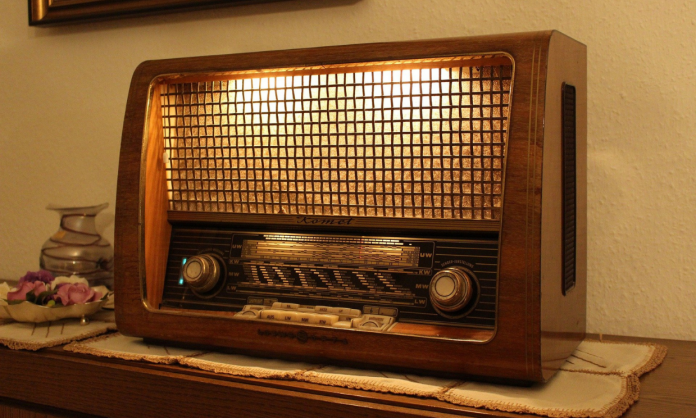By Eddie Bohan
At 7pm on Valentine’s Day February 14th 1922, Britain’s first scheduled radio station 2MT first began broadcasting every Tuesday night from the small Essex town of Writtle. The station was the experimenter arm of the Marconi Company with Captain Peter Eckersley in charge. Each night the station would go on air at 7pm with Marconi’s publicity man in London, Arthur Burrows, despatching gramophone records to be played and artistes to perform live.
When Eckersley arrived at the station, he reduced the formalities that restricted 2MT’s broadcasts. This often occurred after the staff had visited the nearby pub The Cock & Bull and imbibed themselves with numerous gin and tonics. There were reports that MPs rushed from the House of Commons at 7pm to tune into 2MT, pointing to its instant success. It was in the midst of this growing success that the first Irish artist appeared on the radio, or the wireless, for the purposes of listening-in as it was known as at the time.
At 7pm on May 16th 1922 Captain Eckersley introduced the artist of the night, Isolde O’Farrell. O’Farrell had been sent from London, where she had been making a name for herself on the stages in the capital. She was a familiar sight at Irish music events especially on St Patrick’s Day and was a darling of the Gaelic League in London. In 1920, she had sung ‘The Soldier’s Song’ which would later become the Irish national anthem, receiving a tremendous reception to her performance.
‘The Bio’ entertainment newspaper reported,
‘I had the ear-pieces on and by means of the radio-telephony system was prepared to listen to a concert being given by Miss Isolde O’Farrell, sixty to seventy miles away, at Writtle. My hopes of hearing the concert were realised or at least a portion of it. Miss O’Farrell sang “Softly Awakes My Heart,” the famous aria from “Samson and Delilah”, “The Maori Song” by Alfred Hall, “Life’s Roadway” by Emmett Adams (accompanied by the composer); and Hermann Lohr’s “The Little Irish Girl”.
The latter was a rich and rare treat. Words and accent, the notes of the piano, could be heard by myself and all around, and it was a curious experience to listen to this delightful song being sung, say, seventy miles away. With the generous permission of the Post Office, the Marconi Company broadcast this concert, and thanks to the fact that there was an instrument in Chesham, myself and others were able to enjoy the concert. Much of the music was very clear, now and again it was rather spoilt, and this I was given to understand was caused by some other station on the same wave-length jamming.’
Isolde O’Farrell immediately began to cash in on her success over the airwaves as the Pall Mall Gazette (May 22nd 1922) reported the following week,
‘Miss Isolde O’Farrell, the Queens and Albert Hall dramatic Soprano, whose songs were successfully radiated on 600-metre wavelength from the Marconi station at Writtle Essex last Tuesday, will appear at the Kingsway Theatre today and on Wednesday, Thursday and Friday afternoons.’
O’Farrell’s historic broadcast was followed by another piece of history, the first radio appeal that would morph one day into BBC’s Children in Need. According to the newspaper reports,
‘A Wireless Appeal for the Listeners-in of the periodical concert conducted on Tuesday Marconi’s transmission station Writtle were delighted to hear what must have been novel appeal. Hundreds of amateurs within a radius of metres enjoyed the musical programme, which this occasion was preceded by beautifully worded address by Mrs. Stanley Lupino, the wife the famous comedian, behalf of the Children’s Fresh-Air Fund.’
Mrs Lupino was the wife of the famous vaudeville and film star, Stanley Lupino. She was a performer in her own right known on stage as ‘Connie Emerald’. She had been born Constance Gladys O’Shea to Irish parents. The couple were parents to the Hollywood star Ida Lupino.
In the days prior to internet searches many artistes embellished their background stories to make themselves more appealing to both the public and producers. There was also a tendency for artists who would agree to appear on the new medium of radio to use pseudonyms to avoid issues with their gramophone record labels who initially felt that radio would be a disaster for the business of selling records and music sheets.
The newspapers reported that O’Farrell was from Dublin, a former Irish hockey international and sung as a Soprano. In March 1922 just months before her appearance on the ether, she performed at the Queens Hall Theatre the ‘Mystery Waltz Song’ by Emmet Adams which was described in the ‘Daily Mirror’ as ‘one of the most beautiful Viennese waltz songs ever written’.
However, to add a little mystery of its own to this story, the following appeared in the newspapers in 1924 indicating that O’Farrell may in fact be a Tipperary born singer named Oonah Mairs. The search goes on.








